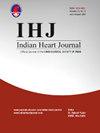Factor XI and XII inhibitors–Dawn of a new era
IF 1.8
Q3 CARDIAC & CARDIOVASCULAR SYSTEMS
引用次数: 0
Abstract
The history of coagulation cascade dates back to 17th century. The extrinsic and intrinsic pathways were proposed in 1998. Extrinsic pathway includes the tissue factor and stable factor which activates factor X and with help of factor V, this converts prothrombin to thrombin which is stabilised by factor XIII. This helps to seal the bleeding vessel and is a physiological process as there is only “limited” production of thrombin which doe not expand beyond the damaged site due to absence of tissue factor. On the other hand intrinsic pathway is activated by polyanions, neutrophilic extracellular traps which are present during infection and inflammation. These activate factor XI which activates factor X with the help of factor IX and VIII and then the common pathway ensues. But newer discoveries have shown that this is a very simplified way of explaining the coagulation system. The researches propose that haemostasis is divided into initiation, amplification and propagation phase. Also, the factor VII-tissue factor complex formed activates factor IX and leads to sustained thrombin production as the amount of thrombin produced by extrinsic pathway alone is not sufficient to form a haemostatic plug. Thrombin also activates factor XI and lead to self perpetuation of intrinsic pathway.
All the anticoagulants have an inherent property of bleeding. So the newer factor XI and XII inhibitors focus to inhibit the excessive thrombin production without hampering the physiological haemostasis process. This is supported by the fact that congenital factor XI and XII deficiency does not cause excessive bleeding but increased levels did make patients more vulnerable to thromboembolism.
This review shall focus on the various factor XI and XII inhibitors which are in the pipeline.
因子XI和因子XII抑制剂——新时代的曙光。
凝血级联的历史可以追溯到17世纪。外在途径和内在途径在1998年被提出。外在途径包括组织因子和稳定因子,它激活因子X,并在因子V的帮助下,将凝血酶原转化为凝血酶,凝血酶被因子XIII稳定。这有助于封闭出血血管,这是一个生理过程,因为凝血酶的产生“有限”,由于缺乏组织因子,凝血酶不会扩展到受损部位之外。另一方面,内在途径被感染和炎症期间存在的多阴离子、中性粒细胞胞外陷阱激活。这些激活因子XI在因子IX和因子VIII的帮助下激活因子X然后共同途径随之而来。但新的发现表明,这是解释凝血系统的一种非常简单的方法。研究认为,止血可分为起始期、扩增期和繁殖期。此外,形成的因子vii -组织因子复合物激活因子IX并导致持续的凝血酶产生,因为仅通过外源性途径产生的凝血酶的量不足以形成止血栓。凝血酶也激活因子XI,导致内在通路的自我延续。所有抗凝血剂都有出血的固有特性。因此,较新的因子XI和XII抑制剂的重点是抑制过多的凝血酶的产生,而不妨碍生理性止血过程。先天因子XI和XII缺乏不会导致过度出血,但水平升高确实使患者更容易发生血栓栓塞,这一事实支持了这一观点。本文将重点介绍正在研发中的各种因子XI和因子XII抑制剂。
本文章由计算机程序翻译,如有差异,请以英文原文为准。
求助全文
约1分钟内获得全文
求助全文
来源期刊

Indian heart journal
CARDIAC & CARDIOVASCULAR SYSTEMS-
CiteScore
2.60
自引率
6.70%
发文量
82
审稿时长
52 days
期刊介绍:
Indian Heart Journal (IHJ) is the official peer-reviewed open access journal of Cardiological Society of India and accepts articles for publication from across the globe. The journal aims to promote high quality research and serve as a platform for dissemination of scientific information in cardiology with particular focus on South Asia. The journal aims to publish cutting edge research in the field of clinical as well as non-clinical cardiology - including cardiovascular medicine and surgery. Some of the topics covered are Heart Failure, Coronary Artery Disease, Hypertension, Interventional Cardiology, Cardiac Surgery, Valvular Heart Disease, Pulmonary Hypertension and Infective Endocarditis. IHJ open access invites original research articles, research briefs, perspective, case reports, case vignette, cardiovascular images, cardiovascular graphics, research letters, correspondence, reader forum, and interesting photographs, for publication. IHJ open access also publishes theme-based special issues and abstracts of papers presented at the annual conference of the Cardiological Society of India.
 求助内容:
求助内容: 应助结果提醒方式:
应助结果提醒方式:


